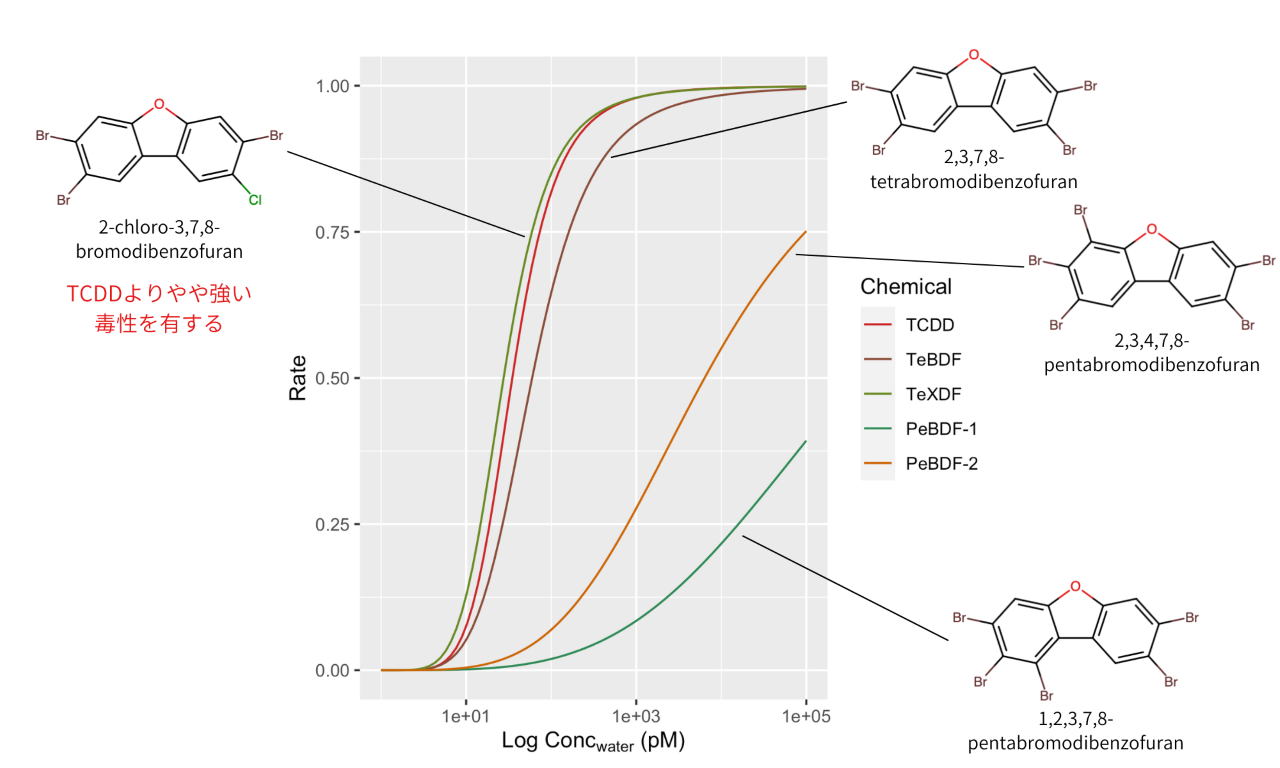Risk management of brominated dioxins in wastewater based on relative toxicity to fish
Some mixed halogenated dioxins are more toxic than TCDD
•The toxicity of brominated dioxins was evaluated by an early-life stage toxicity test in Japanese medaka.
•2,3,7,8-substituted brominated dibenzofurans caused typical effects of dioxin-like compounds, such as blue-sac disease.
•The uptake rate of brominated dioxins needs to be considered in addition to their relative potencies in the risk assessment of aquatic environments.
•Some mixed-halogenated dioxins may have a higher toxicity potential than TCDD, and their environmental behavior needs to be monitored.
World Health Organization toxic equivalency factors (WHO-TEFs) are recommended for the risk management of brominated dioxins in aquatic environments because limited information is available on their toxicity to fish. To validate this approach, we obtained the relative potencies of polybrominated dibenzo-p-dioxins and polybrominated dibenzofurans and mixed-halogenated furans (PXDF, X = Cl/Br) against 2,3,7,8-tetrachlorodibenzo-p-dioxin (TCDD) based on their toxicity to the early-life stage of Japanese medaka (Oryzias latipes). 2,3,7,8-substituted brominated dibenzofurans caused typical dioxin exposure effects, such as blue-sac disease. The TCDD-relative potency factors (REPs) of the test substances were calculated based on the concentrations in water and eggs that caused 20% lethality on day 28 post-fertilization, and were in the order of: 2-chloro-3,7,8-tribromodibenzofuran (REPwater 3.3, REPegg 4.6) > 2,3,7,8-tetrabromodibenzofuran (0.85, 0.92) > 2,3,4,7,8-pentabromodibenzofuran (0.053, 0.55) > 1,2,3,7,8-pentabromodibenzofuran (0.0091, 0.19). The transfer rate from water to eggs was lower for pentabrominated furans than tetrabrominated congeners, and was expected to decrease with the log Kow of the test substance. Although the REPegg value can be used to compare the toxicity potential of brominated dioxins, REPwater may be more suitable for environmental risk assessment because the uptake potential of these compounds from water should be considered. This study is the first to report a higher toxicity of a PXDF congener compared with TCDD in vivo. Further investigations of the toxicity of mixed-halogenated dioxins and environmental behavior are necessary for environmental risk assessment.
Reference URL: https://doi.org/10.1016/j.ecoenv.2022.114227
Bibliographic Information
Determination of the relative potencies of brominated dioxins for risk assessment in aquatic environments using the early-life stage of Japanese medaka.
Kei Nakayama, Nguyen Minh Tue, Naoto Fujioka, Hideaki Tokusumi, Akitoshi Goto, Naoto Uramaru and Go Suzuki.
Ecotoxicology and Environmental Safety, 247, 114227, doi: 10.1016/j.ecoenv.2022.114227, 2020 (October 26).
Fundings
- Environment Research and Technology Development Fund (no. 5-1705: JPMEERF20175005)
Media
-

Dose-response curves of brominated dioxins
Relationship between exposure concentrations of TCDD (red line) or each brominated dioxin and mortality at 28 days post-fertilization. Comparing compounds with halogen substitutions at positions 2, 3, 7, and 8, the mixed halogenated compounds were more toxic than the tetrachlorinated (TCDD) and tetrabrominated (TeBDF) compounds.
credit : Kei Nakayama
Usage Restriction : Please get copyright permission -

Brominated dioxins released into the environment through wastewater
Brominated dioxins with halogen substituted at positions 2, 3, 7, and 8 in wastewater from brominated flame retardant handling facilities cause a typical effect of dioxin-like compounds called "blue-sac disease" on medaka fish in the early developmental stage.
credit : Kei NAKAYAMA
Usage Restriction : Please get copyright permission
Contact Person
Name : Kei NAKAYAMA
Phone : +81-89-927-8132
E-mail : kei_n@ehime-u.ac.jp
Affiliation : Center for Marine Environmental Studies

